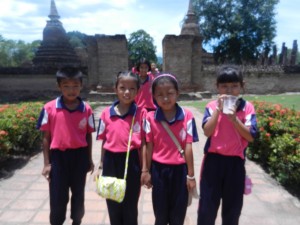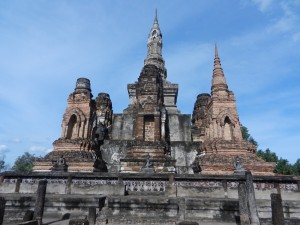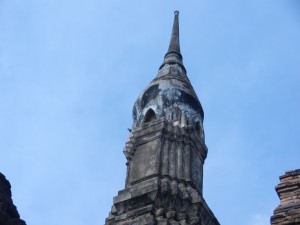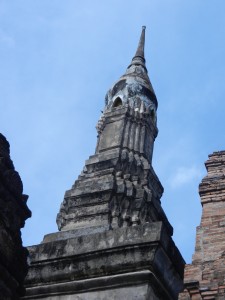Wat Mahathat was Sukhothai’s ritual center from the time when it liberated itself from the Khmers in the 13th century. Its graceful forms created a standard that Thai artists have measured themselves by ever since. They also provided a model of how the world coheres.
I saw several groups of impeccably behaved schoolkids in spic and span uniforms lilting around Wat Mahathat. I saw them in my previous visit too, in 2007. Thais still consider it an archetype of how the world hangs together.
Most of Wat Mahathat’s look was created in the 14th century. In the 1340’s King Lo Thai rebuilt its central shrine to house hair and neck bones of the Buddha, which were brought from Sri Lanka. An inscription from his reign said that the original platform had collapsed.
Lo Thai repaired the platform (made from laterite) and restored the brick towers on it, but he added features which have been examples of Thai grace ever since.
One of Sukhothai’s most admired features is the lotus bud shape of Wat Mahathat’s central spire. Carol Stratton and Miriam McNair Scott, in The Art of Sukhothai, said that Lo Thai might have gotten the idea of using a lotus bud as an architectural form from Pagan. They said that he wanted to give Wat Mahathat a soft and spiritual look and that he probably looked back to older monuments for ideas in order to project their supernatural power. But the way this form was adapted at Sukhothai was an original expression of Thai culture.
The tower’s slender and slowly tapering form fuses with the bud at the top into a web of ideas that blends spiritual energies, grace and vegetal growth–Sukhothai depended on irrigated rice farming. The indentations in each corner make the energies look like the gently flowing water in rivers and canals.
Wat Mahathat’s central spire tapers in several sections. Its refined mixture of plant forms, the flow of water, spiritualized energy and the Buddha’s compassion became an example of how the society is ordered. Stratton and McNair Scott said that the lotus bud tower became a symbol of political and religious power throughout the Sukhothai kingdom. Sukhothai replicated it in other town’s ritual centers.
Though I took the above photo in Luang Prabang’s royal palace, Sukhothai probably performed courtly dances too. The Khmers already did before Sukhothai liberated itself from them. Laotians are ethnically Thai and Luang Prabang and northern Thailand had close relations when their kingdoms flourished before devastating wars with the Burmese in the 16th century. The graceful movements from Thai court dances and religious processions meshed with the emerging architectural forms into ideals of beauty and tolerance which I don’t think any culture has surpassed.
But we’ve only seen one part of Wat Mahathat. We’ll float through more of it in the next post on Sukhothai.







Comments on this entry are closed.